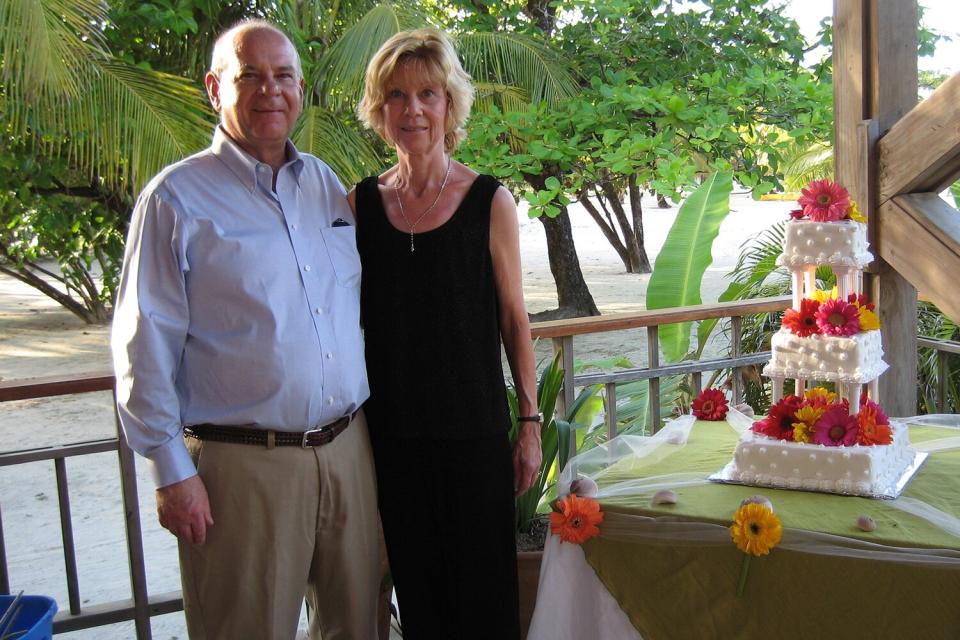Celine Dion's Rare Condition Is a 'Horrible Disease' Says Woman with Stiff Person Syndrome
Céline Dion revealed Thursday morning in a tearful Instagram video that she's been diagnosed with Stiff-Person Syndrome, sharing that the condition would force her to postpone and cancel a series of upcoming concert dates as she learns about the rare condition and how it impacts her life.
Stiff Person Syndrome is a rare and incurable neurological disease that affects the central nervous system, specifically the brain and spinal cord, causing symptoms like "hyper-rigidity, debilitating pain, chronic anxiety," and muscle spasms "so violent they can dislocate joints and even break bones," according to the Stiff Person Syndrome Foundation.
Only one of every one million people have been diagnosed with the condition.
One of those people is Maureen Materna. The 74-year-old Ohio resident opened up to PEOPLE about the reality of living with the condition, which she was diagnosed with in 2011.

Maureen Materna
"It's a horrible disease," she says. "Maybe now with Celine Dion getting this, maybe they'll do more research because I really don't think they've done too much research because it's so rare. One out of a million people have it. When I go to a doctor, they'll say, 'What the heck is Stiff Person Syndrome? I never even heard of it.'"
Materna was 64 when she started experiencing severe pain in her feet, back and legs. She recalls frequent cramps in her foot that lasted 45 minutes.

Virginia Sherwood/NBC/NBCU Photo Bank/Getty Images Celine Dion
As someone who has always been active and has exercised, she quickly went to the emergency room when the pain persisted. However, all tests came back normal and, on paper, Materna was perfectly healthy. It took two years and numerous doctors before she got answers.
"I probably went to 20 different doctors, foot doctors, chiropractors, rheumatologists, neurologists, back doctors. Nobody knew anything," she explains. "They said I had a parasite or they would just come out and say there's nothing wrong with you, you're fine."
"It's frustrating. It's very frustrating," Materna adds. "And it's just like, what in the world am I gonna do?"
Never miss a story — sign up for PEOPLE's free daily newsletter to stay up-to-date on the best of what PEOPLE has to offer, from juicy celebrity news to compelling human interest stories.

Maureen Materna
RELATED: Céline Dion Is a 'Picture of Resilience' amid Stiff-Person Syndrome Diagnosis: Source
After visiting the Cleveland Clinic, Materna was ultimately diagnosed with Stiff Person Syndrome in 2011. Managing the condition has been extremely difficult and she says the pain is often debilitating, specifically in her feet.
"It's hard because I'm always in pain. Anything I do, my nerves just go crazy," she explains. "I couldn't even wear shoes for nine years. My feet were so stiff and sore. When I walk it's like walking on broken glass."
"My life is not the same," Materna tells PEOPLE, noting that she's no longer independent and can't do the things she loves anymore. "I have grandchildren in Chicago and I can't visit them. Or even when they come here, my husband's gonna take them to see a play and I can't go and sit there. Even when I watch TV at night, I have to get up during all the commercials and move around or I stiffen up like crazy."
Because Stiff Person Syndrome is incurable, treatment is aimed at addressing symptoms and improving mobility and comfort.
For Materna, doctors tried many therapies for her symptoms but stopped after they caused migraines and blood clots. She also tried acupuncture, acupressure, biofeedback, neurofeedback, and physical therapy to manage her pain.
She's only able to manage the spasms and pain today by taking Valium and staying healthy and as active as possible.
"You just have no choice. Either lay down and die or fight it and I want to fight it," Materna says. "I just keep that positive attitude. If I have a negative thought I try to think of two positive things to be grateful for. I handle it that way."


